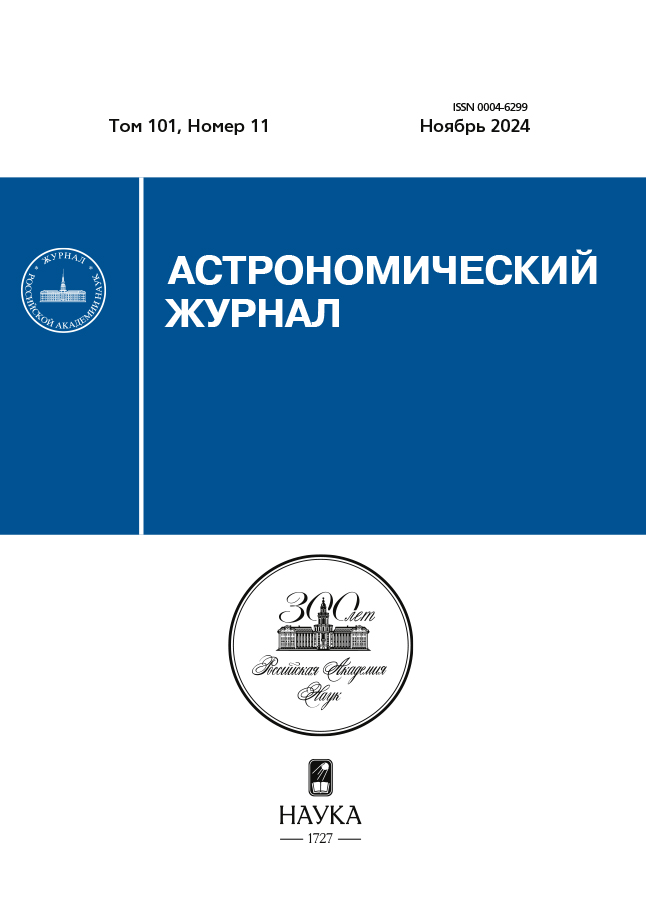Flare June 7, 2011, and analysis of eruptive prominence fragments
- Авторлар: Kupryakov Y.A.1, Bychkov K.V.1, Maliutin V.A.2, Gorshkov A.B.1, Belova O.M.2
-
Мекемелер:
- Lomonosov Moscow State University, Sternberg Astronomical Institute
- Lomonosov Moscow State University
- Шығарылым: Том 101, № 11 (2024)
- Беттер: 1003-1009
- Бөлім: Articles
- URL: https://archivog.com/0004-6299/article/view/647682
- DOI: https://doi.org/10.31857/S0004629924110066
- EDN: https://elibrary.ru/JKYUAC
- ID: 647682
Дәйексөз келтіру
Аннотация
Solar flares can be accompanied by high plasma velocities exceeding several hundred km/s. Detection and measurement of such velocities is limited by narrow-band and small wavelength range in most solar instruments. However, similar events with Doppler velocities exceeding two hundred km/s have been detected by the solar optical spectrographs at the Ondřejov Observatory. We present the results of the analysis of our multi-wavelength observations performed during the solar flare of June 7, 2011 and the calculation of several physical parameters of the eruptive prominence fragments following the flare. The calculation of the radiation of heated gas are performed taking into account self-absorption in the spectral lines of hydrogen and calcium. All the crucial processes of discrete level populating and depopulating are taken into account in the balance equations. The theoretical radiation fluxes in the lines coincide with those observed in the temperature range of 6300–10000 K at a gas concentration of about (3–5) × 1010 см–3 , a gas layer thickness of 6800–7000 km and a column density of (2–4) × 1019 см–2 .
Негізгі сөздер
Толық мәтін
Авторлар туралы
Yu. Kupryakov
Lomonosov Moscow State University, Sternberg Astronomical Institute
Хат алмасуға жауапты Автор.
Email: kupry@asu.cas.cz
Ресей, Moscow
K. Bychkov
Lomonosov Moscow State University, Sternberg Astronomical Institute
Email: kupry@asu.cas.cz
Ресей, Moscow
V. Maliutin
Lomonosov Moscow State University
Email: kupry@asu.cas.cz
Faculty of Physics
Ресей, MoscowA. Gorshkov
Lomonosov Moscow State University, Sternberg Astronomical Institute
Email: kupry@asu.cas.cz
Ресей, Moscow
O. Belova
Lomonosov Moscow State University
Email: kupry@asu.cas.cz
Faculty of Physics
Ресей, MoscowӘдебиет тізімі
- F. Reale, S. Orlando, P. Testa, E. Landi, and C. J. Schrijver, Astrophys. J. Letters 797(1), id. L5 (2014).
- D. R. Ardila, G. J. Herczeg, S. G. Gregory, L. Ingleby, et al., Astrophys. J. Suppl. 207(1), id. 1 (2013).
- P. Gouttebroze, P. Heinzel, and J. C. Vial, Astron. and Astrophys. Suppl. Ser. 99, 513 (1993).
- P. Gouttebroze, J. C. Vial, and P. Heinzel, Solar Phys. 172(1–2), 125 (1997).
- В. В. Соболев, Курс теоретической астрофизики. 3-е изд-е (М.: Наука, 1985).
- О. М. Белова, К. В. Бычков, Астрофизика 61(2), 255 (2018).
- L. C. Johnson, Astron. J. 174, 227 (1972).
- Г. Грим, Уширение спектральных линий в плазме (М.: Мир, 1978).
- Y. Ralchenko, A. Kramida, J. Reader, and NIST ASD Team, 2014; Atomic Spectra Database (version 5.0), http://physics.nist.gov/asd .
- W. Cunto and C. Mendoza, Revista Mexicana Astron. Astrof. 23, 107 (1992).
- L. C. Green, P. P. Rush, and C. D. Chandler, Astrophys. J. Suppl. 3, 37 (1957).
- M. Meléndez, M. A. Bautista, and N. R. Badnell, Astron. and Astrophys. 469(3), 1203 (2007).
- H. van Regemorter, 136, 906 (1962).
- A. N. Cox (ed.), Allen’s astrophysical quantities (New York: Springer, 2000).
- D. R. Williams, D. Baker, and L. van Driel-Gesztelyi, Astrophys. J. 764(2), id. 165 (2013).
- J. Carlyle, D. R. Williams, L. van Driel-Gesztelyi, D. Innes, A. Hillier, and S. Matthews, Astrophys. J. 782(2), id. 87 (2014).
- D. E. Innes, P. Heinrich, B. Inhester, and L.-J. Guo, Astron. and Astrophys. 592, id. A17 (2016).
Қосымша файлдар













